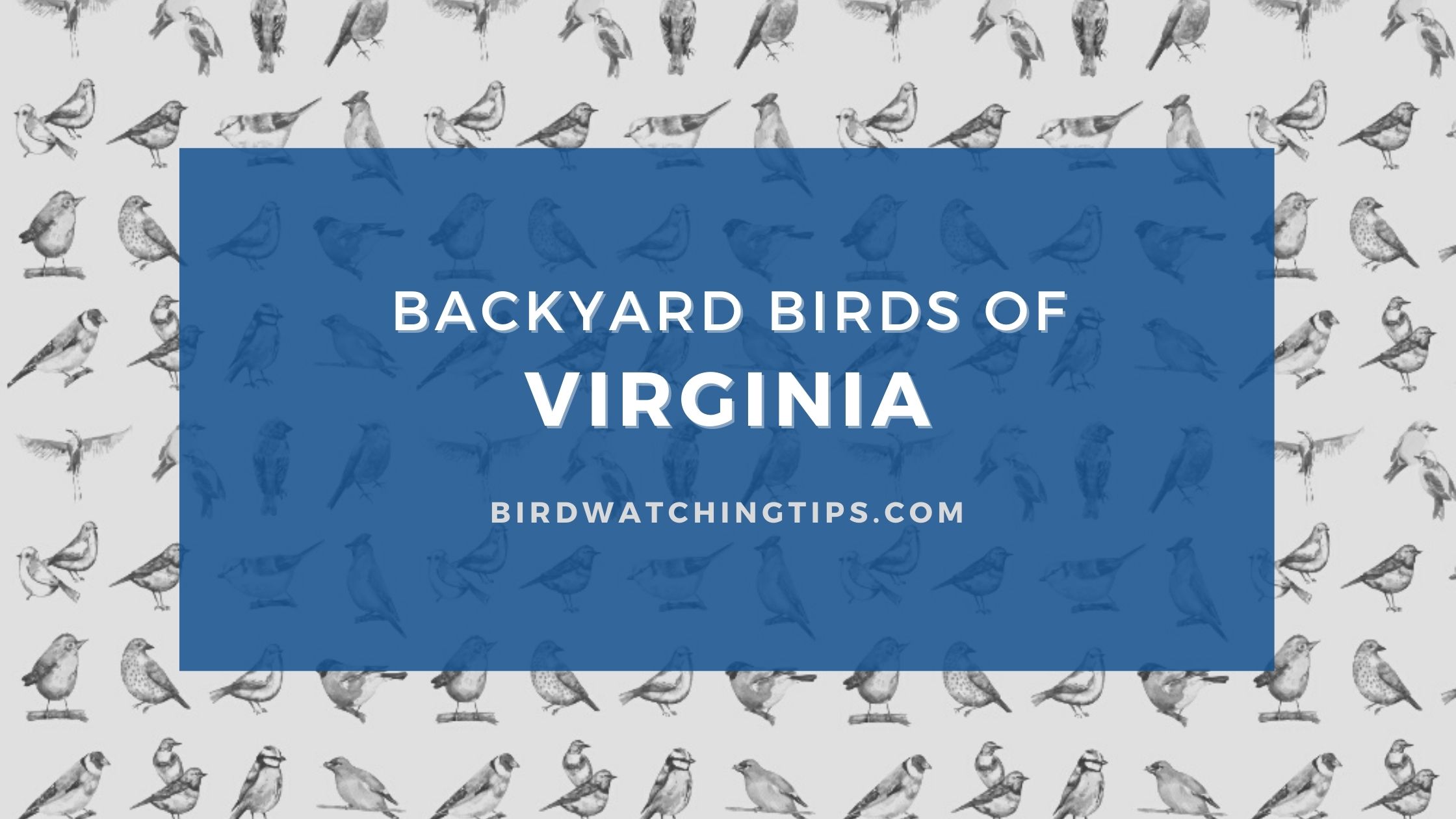When it comes to birdwatching, Virginia is an excellent place to be. Not only were they the first state to develop a statewide wildlife and birding trail system but said system includes a wide variety of environments. Mountains, coasts, you name it… Virginia is simply an amazing place for birdwatchers.
Today we’ll talk about some birds to look for in your backyard, give you some feeder advice, and share a few trails for when you feel like taking a little trip to see some new feathered friends.
Without further ado, let’s talk about the popular backyard birds of Virginia!
3 Categories – 474 Birds
Virginia definitely has no shortage of Avian inhabitants. According to the Virginia Avian Records Committee there are 474 recorded species that are sited in this state. While we can’t possibly list them all, we have selected a handful that we are going to talk about. Specifically, 5 birds that you can look for in 3 different divisions of seasons. We’ll divide them up as follows:
- Year-round Resident birds
- Birds of Spring, Summer, and Early Fall
- Fall and Winter Birds
We’ll tell you about their distinctive markings, their sizes, and even a little about what you can put in your feeder to tempt these little wonders of Nature. While we can’t guarantee that this will lure them in (they’re shy, as you know, and other birds can be bullies), this information should at least help to give you a little edge. Let’s start with the year-round birds first!
Virginia’s Year-round Resident birds
If you live in Virginia then you’ve probably fallen in love with the scenery. Forests abound, you’ve got mountain areas, and you can even bird in the coast or visit marshes. These birds below, like you, have decided to make their home in the Commonwealth and may be spotted at any time of the year:
- Eastern Bluebird
- Carolina Wren
- Northern Cardinal
- White-throated Sparrow
- Northern Mockingbird
Eastern Bluebird – Sialia sialis
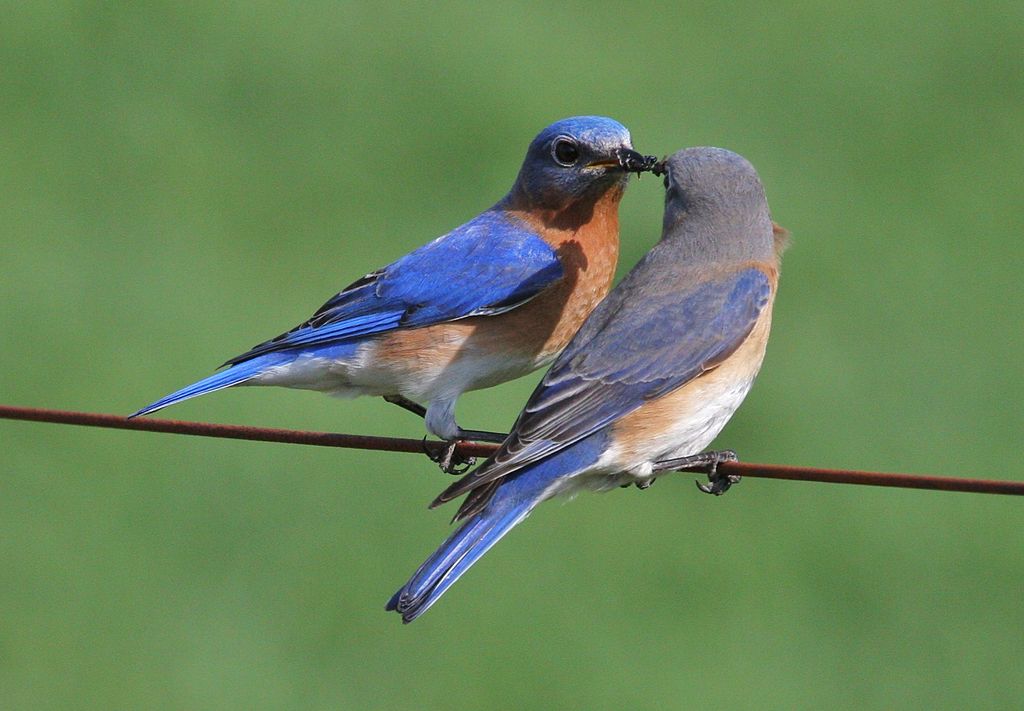
Coloration and Markings: As with many birds, there is some variation in colors between the genders. Male Eastern Bluebirds have deep blue wings and tail while the breast is a rust-red color. This color continues up, creating a rust-colored band that separates the head from the wings. The underbelly, by contrast, is white. The face is blue and has a medium-sized, slightly curved bill. Female Bluebirds have more subdued blues and rust and incorporate gray into their upper plumage.
Size: These birds measure in at 6.3 – 8.3 inches from head to tail and have wingspans of 9.8 to 12.6 inches.
Habitat: Look for them in meadows, golf courses, parks, and possibly your backyard. Load up that feeder and you might just get their attention.
Diet: Eastern Bluebirds are kind of picky. If you want them to visit your feeder then mealworms are going to be the ticket.
Carolina Wren – Thryothorus ludovicianus

Coloration and Markings: These birds have auburn wings and tail, with some black and white accents that make small, checkered patterns. Their breast and underbelly is a yellowish-orange color and facially, these birds have white faces with a rust-colored ‘eyebrow’, as well as a rust colored cap. They have long bills that have a very slight curve to them.
Size: These Wrens measure in at 4.7 – 5.5 inches in length with wingspans of approximately 11.4 inches.
Habitat: These birds love the protection of shrubberies and thickets, so whether it be in the woods or if you have some dense vegetation in your backyard, this is likely where they will be.
Diet: Berries and mealworms are an excellent way to lure in Carolia Wrens to your feeder. Sometimes they will eat seeds too, so add some Black Oil sunflower seeds for good measure.
Northern Cardinal – Cardinalis cardinalis
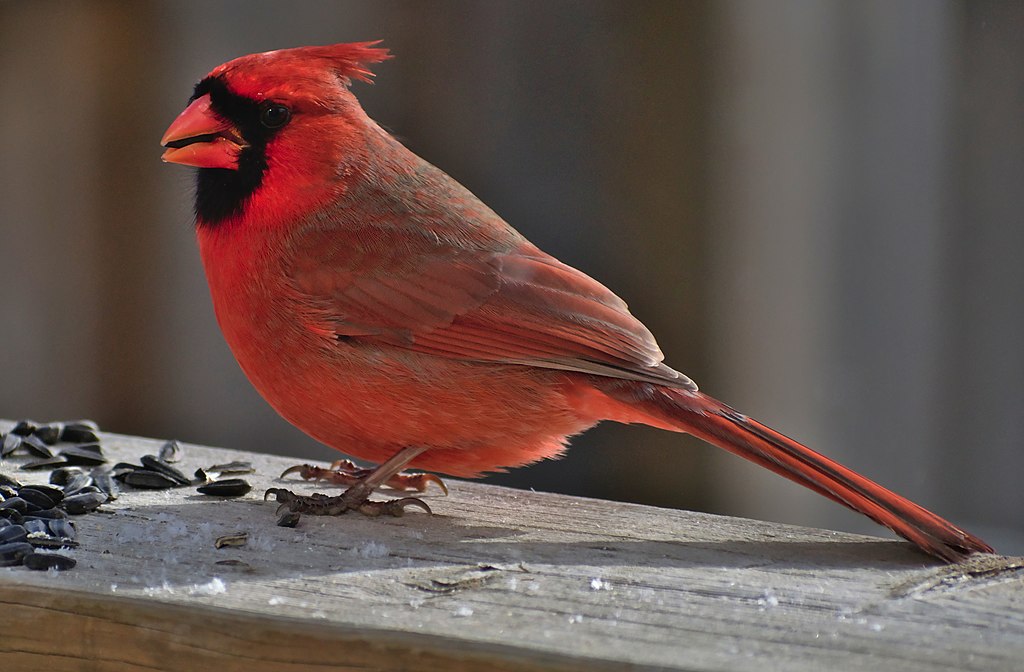
Coloration and Markings: A favorite of many birdwatchers, the Northern Cardinal is one of those few birds that is actually harder NOT to spot. These birds are almost completely red. The upper and lower body is red, as well as the conical bill, with a distinctive exception of the Cardinal’s eye mask. This mask goes across the eyes and carries own down to the chin. Females do have different coloration, however, but you’ll still know it’s a cardinal. They are simply brown with red tints spotting around their plumage.
Size: A good sized bird, Northern Cardinals measure in at 8.3 – 9.1 inches in length and have wingspans of 9.8 to 12.2 inches.
Habitat: These birds typically may be found around the forest edge, parks, and definitely in backyards. These birds know that backyards often have treats, so don’t disappoint them!
Diet: These birds will eat just about anything you put out but they really love Black Oil sunflower seeds.
White-throated Sparrow – Zonotrichia albicollis
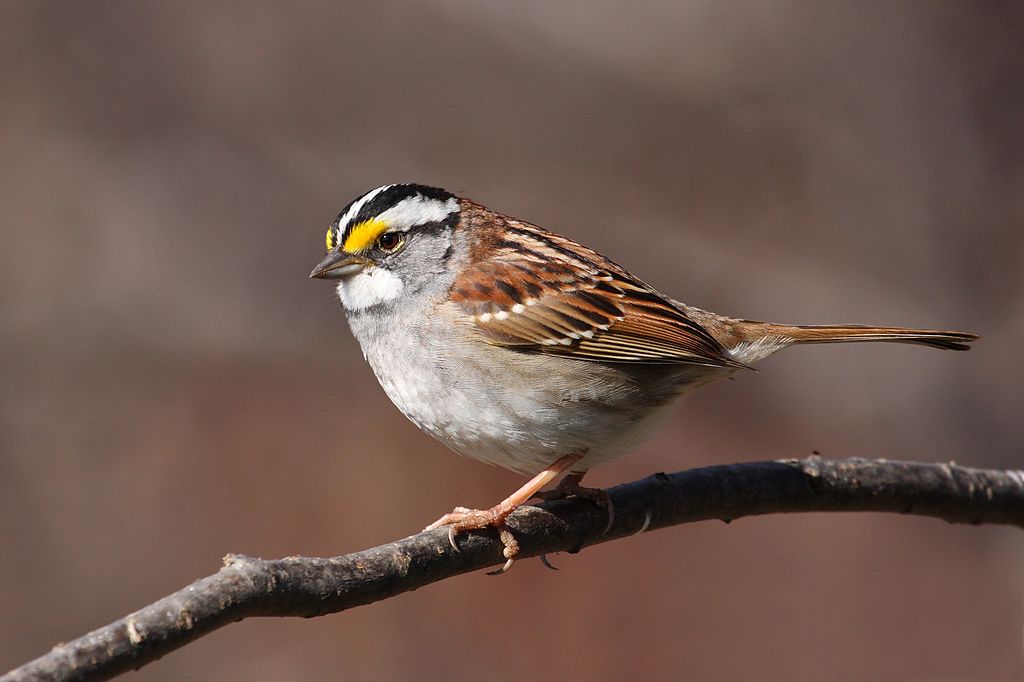
Coloration and Markings: White-throated Sparrows have brown wings with some white accents on the shoulder portions and they have long, brown tails. Their breast and underbelly are gray and this gray extends up into the face, going around the chin area to the back of the neck and the underside of the eye. The chin of this bird is black and a black line extends behind the eye and curves up to the back of the neck. Above this, the bird has a large white ‘eyebrow’ which turns yellow just in front of the short, conical bill. The coloration is complete with the addition of the bird’s ‘skunk cap’, which is simply a white central stripe on the top of the black upper portion of the head. It’s a striking bird that you’ll recognize quickly once you’ve seen one. Sometimes you will see a variety that has brown and white instead of black and white and these Sparrows are commonly referred to as being ‘tan striped’.
Size: These birds measure in at 6.3 – 7.1 inches with wingspans of 7.9 to 9.1 inches.
Habitat: These birds like woods and thickets and are fond of water as well. They are not shy about visiting backyards, however, so plan appropriately.
Diet: These birds love Black Oil sunflower seeds as well as millet. They like to forage on the ground, however, so sprinkle a little around the base of your feeder after you’ve loaded it up for best results.
Northern Mockingbird – Mimus polyglottos

Coloration and Markings: Northern Mockingbirds have grayish brown wings and tail, with spectacular white wingbars and white outer tail feathers. Their breast and underbelly are white to grayish white and this coloration continues to the bottom half of the bird’s face. The upper half is the same grayish-brown as the wings and this bird has a short, straight black bill.
Size: These birds measure in at 8.3 – 10.2 inches and have wingspans that range between 12.2 to 13.8 inches in length.
Habitat: Aside from the forest’s edge, these are very much city birds. You can find them in parks, backyards, or just hanging around in a convenient tree in town.
Diet: These birds are shy around feeders but if you have fruits growing in the backyard then they will find this appealing. Blackberry vines are an easy and tasty addition to the yard if you would like to lure these birds in.
Virginia’s Birds of Spring, Summer, and Early Fall
Some birds in Virginia are best spotted when it’s warm and Nature is showing off its bounty. Some birds that you can spot during the spring, summer, or early fall are as follows:
- Indigo Bunting
- Barn Swallow
- Chimney Swift
- Tree Swallow
- Purple Martin
Indigo Bunting – Passerina cyanea

Coloration and Markings: When it’s time to mate the male Indigo Bunting is pretty much as blue as the Cardinal is red! They have brilliant blue wings with some gray accenting, a long blue tail, and a blue face. You may see a black line from the bill to the eye but otherwise the head is a slightly richer blue than the overall body. This bird has a stout, silver bill.
Size: These birds are tiny, measuring in at 4.7 – 5.1 inches with wingspans of 7.5 to 8.7 inches.
Habitat: Indigo Buntings love brush, so look for them in thickets and shrubberies, where they like to forage.
Diet: Nyjer and mealworms are a great, but simple combination that will make an Indigo Bunting very happy. Give it a try and see!
Barn Swallow – Hirundo rustica
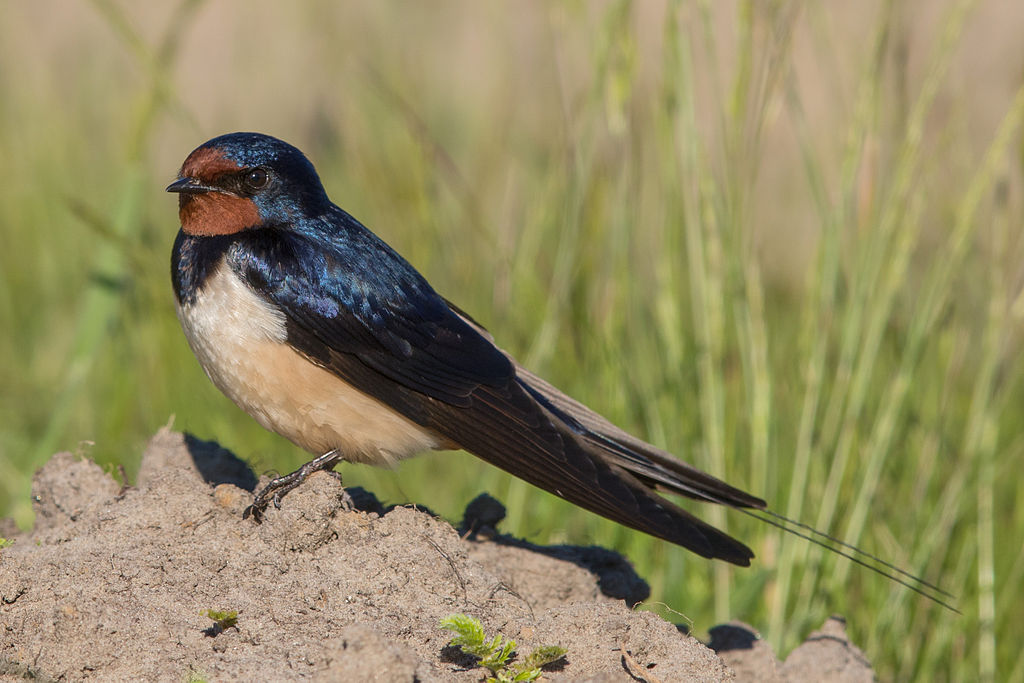
Coloration and Markings: Barn Swallows have blue wings and long, forked blue tails. Their breast and underbelly is a cinnamon color and you’ll notice on the breast that the blue from the wings extends as if the bird is wearing a cape. Facially, the lower half of the birds face is the same cinnamon color up to the cheek (although there is a cinnamon spot just above the nose), while the rest of the head is blue. These birds have short, straight black bills.
Size: Barn Swallows are typically 5.9 – 7.5 inches in length with wingspans of 11.4 to 12.6 inches.
Habitat: These birds like open areas, such as parks and fields, though they also seem to like water. Spotting them near marshes or ponds is not uncommon.
Diet: Barn Swallows like insects, so mealworms are a good bet. Interestingly enough, they will eat eggshell bits if you leave them out. This is believed to help them with digestion.
Chimney Swift – Chaetura pelagica

Coloration and Markings: The coloration of these birds is unremarkable. They tend to be a dark gray and brown all over with the exception of their throats. They are noticeably paler there and these birds also have tiny, curved bills. They do have an interesting shape, however, that will get your attention. In flight they are cigar shaped!
Size: These birds measure in at 4.7 to 5.9 inches in length and have wingspans around 10.6 to 11.8 inches.
Habitat: These birds will forage just about anywhere though when it comes to nesting, they do indeed like chimneys but will accept substitutes such as hollow trees or caves.
Diet: You probably won’t be able to lure one to your feeder. This bird likes to catch insects in flight. You can, however, uncap your chimney and close the flue and a Chimney Sweep might pick your chimney to nest in!
Tree Swallow – Tachycineta bicolor
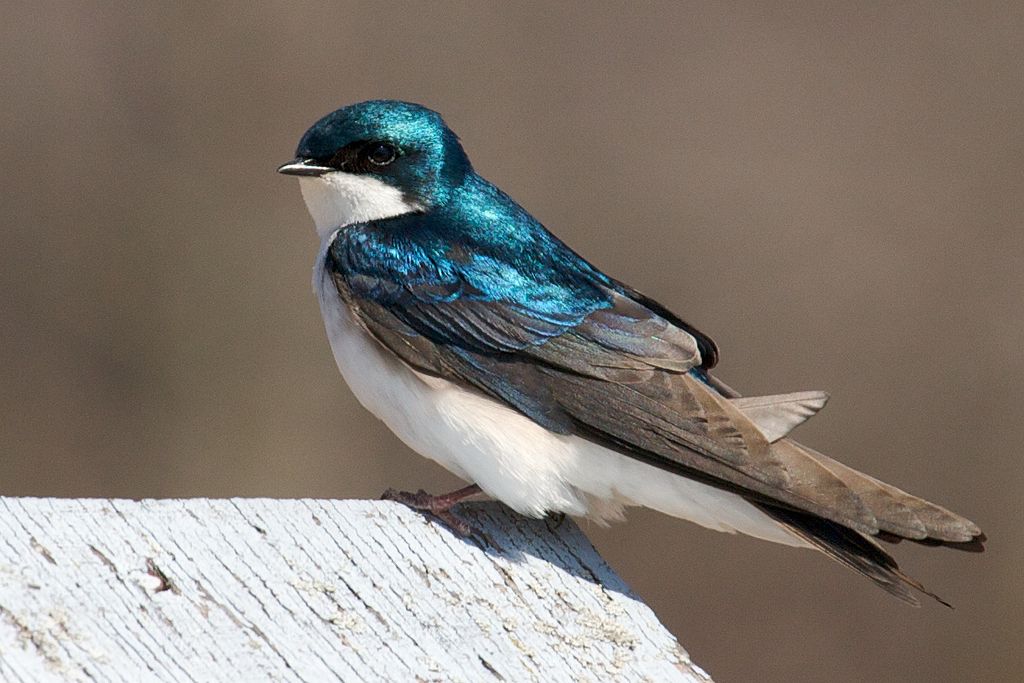
Coloration and Markings: Tree Swallows have a lovely blue-green hue on their backs and most of the rest of their upper body. The lower two-thirds of their wings and their small tails are grayish-black and they have a snow-white breast and lower belly. Facially, the chin and cheeks of this bird are white and they have a black mask that extends back but shops a bit short of the back of the head. Above this, they are blue. They have tiny, slightly curved black bills.
Size: These birds are approximately 4.7 – 5.9 inches in length and have wingspans of 11.8 to 1.8 inches.
Habitat: These birds prefer open areas which are close to water.
Diet: Tree Swallows love insects, so add some mealworms to your feeder, although they will more likely gravitate to any fruit bearing trees or bushes that you might have.
Purple Martin – Progne subis
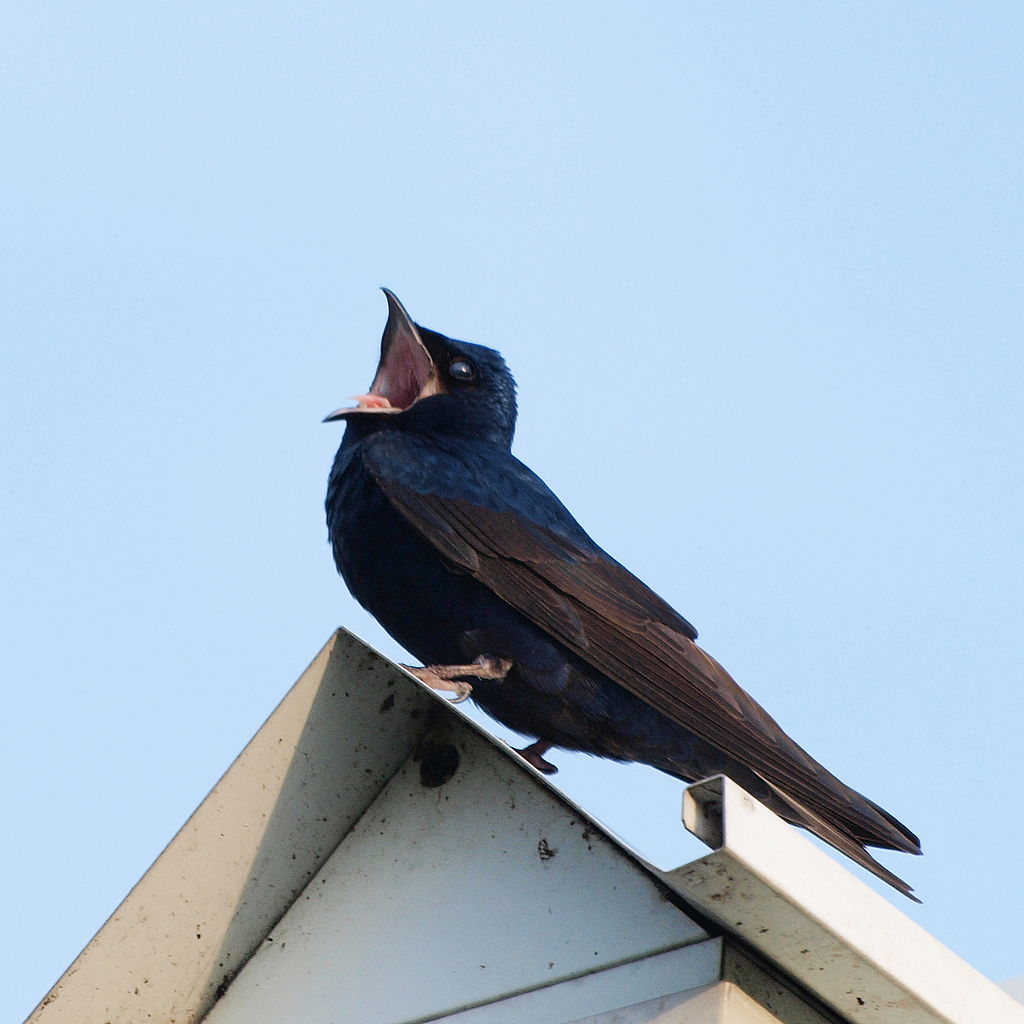
Coloration and Markings: Purple Martins are nothing short of fantastic. Their wings and tail are brown and black while their back, breast, and underbelly is a dark blue and purple color that has to be seen to be believed. Facially, these birds are the same color with the exception of a bold black mask and a short, slightly curved black bill. Females and juveniles exhibit duller colors with some touches of gray.
Size: These are medium-sized birds, measuring in at 7.5 – 7.9 inches with wingspans of 15.3 to 16.1 inches.
Habitat: These birds like open areas, especially those which are close to water, so look for them near ponds or marshes where there is a lot of open-air clearance. They tend to travel in groups and it’s really a sight to be seen.
Diet: This is another bird that appreciates crushed eggshells for digestion. As far as snacks, you might try mealworms and dried crickets.
Virginia’s Fall and Winter Birds
Virginia winters can get chilly, with an average of 26 degrees Fahrenheit (-3.3 Celsius) and some birds decide at this time to pack their bird-bags and leave. Not so with our selection below of birds that you can spot during Virginia’s frigid winters:
- Carolina Chickadee
- American Crow
- Evening Grosbeak
- American Goldfinch
- Common Redpoll
Carolina Chickadee – Poecile carolinensis
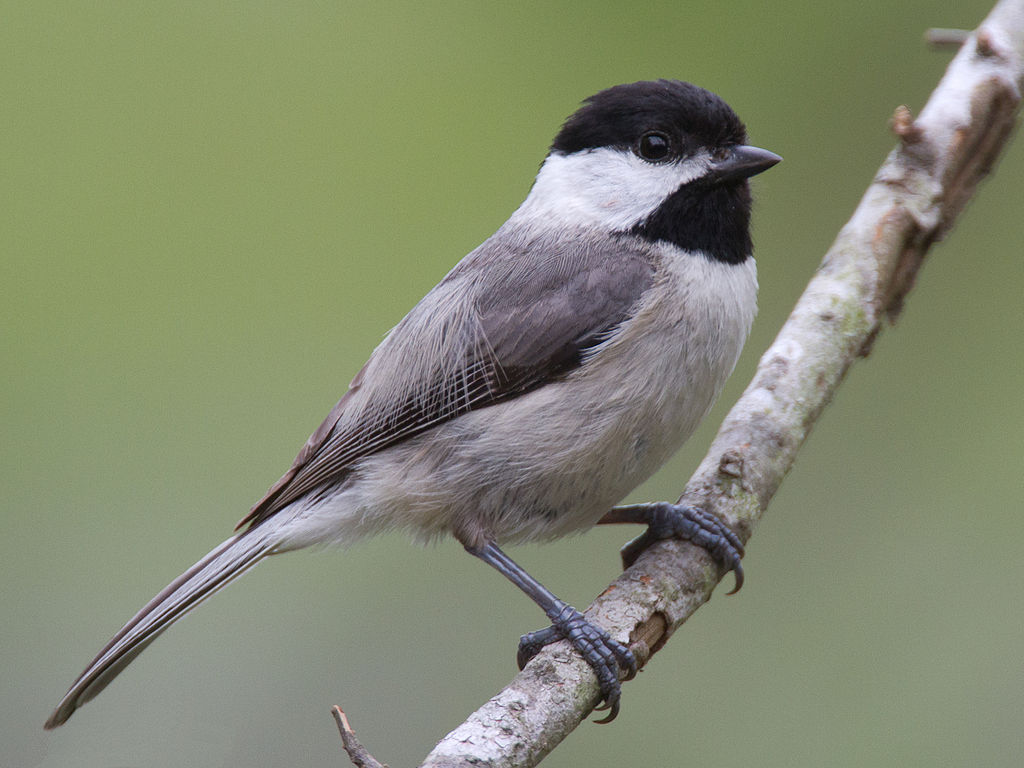
Coloration and Markings: Carolina Chickadees have light gray wings with some black highlights and short gray tails. They have white and gray breasts that darken slightly in color down at the underbelly but these areas are much lighter than the upper body. Facially, these birds have a black chin and throat, while the rest of the space underneath the eye to the back of the neck is snow-white. Above this is a large black cap that takes up the rest of the face. This bird has a tiny black bill.
Size: These little guys measure in at 3.9 – 4.7 inches and have wingspans of 5.9 to 7.9 inches.
Habitat: These birds love large trees when they are in the woods and if you happen to have one or two in your backyard then this is in your favor. If you don’t, they still might well visit your backyard for the right feeder combination.
Diet: Suet, crushed peanuts, and small Black Oil sunflower seeds are a winning combination when it comes to the Carolina Chickadee. If one takes notice that you’ve got these in your feeder then you might be seeing a lot that bird.
American Crow – Corvus brachyrhynchos

Coloration and Markings: Black, black, and black… The American Crow is black from the tip of it’s tail to its long and slightly curved bill.
Size: Crows are big ol’ birds, measuring in at 15.8 – 20.9 inches and with wingspans of 33.5 to 39.4 inches.
Habitat: Fields, forests, and the suburbs! Crows are well adapted to life around people and they have learned the secret of garbage bins, where they love to forage.
Diet: Crows will eat just about anything but they are mindful of their surroundings. These birds are very smart and they prefer open spaces, so if you want to attract them you can put some crushed up peanuts in an open area where they feel safe. Alternately, you can have a crow silhouette 3d printed or cut your own out of tin and perch it on a wall nearby. This is an old Southwest trick, as the birds see the familiar shape of another Crow and move over to investigate.
Evening Grosbeak – Coccothraustes vespertinus
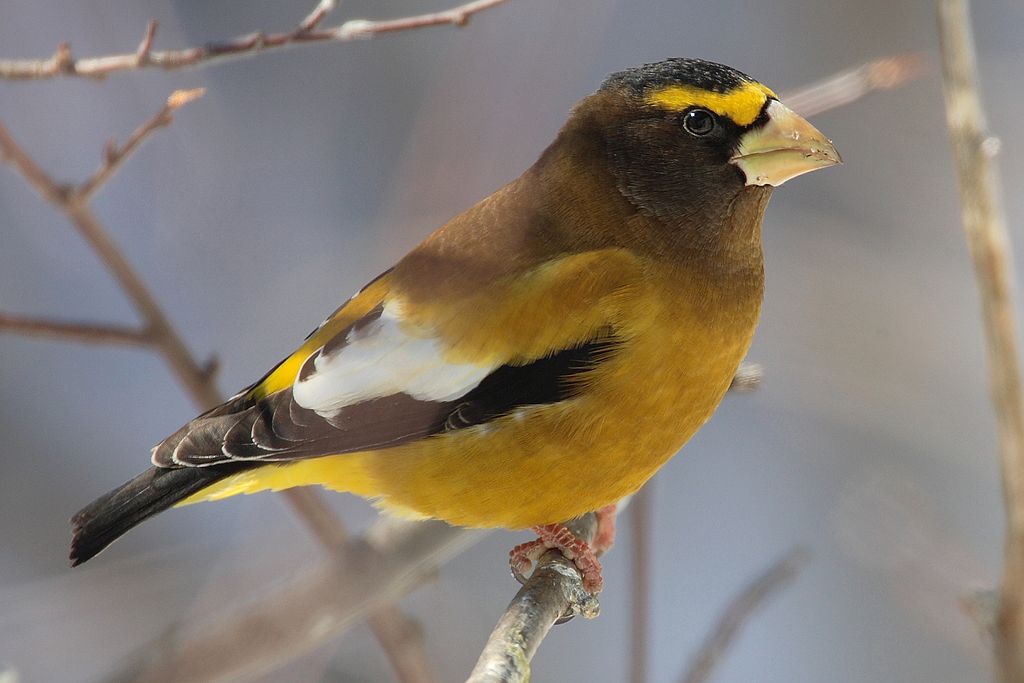
Coloration and Markings: Male Evening Grosbeaks have wings which are yellow towards the shoulders, followed by a large white patch, with the remainder of the wing being black. Their back is a black and gray and they have a yellow breast and underbelly. Facially, they are mostly the same gray-black with the exception of a large yello w’eyebrow’ above their stout and slightly curved light-yellow bills. Females tend more towards the gray with greenish-yellow coloration.
Size: This bird measures 6.3 – 7.1 inches in length with a wingspan of 11.8 to 14.2 inches.
Habitat: These birds usually winter in the woods, fond of oaks and pines alike, but they love backyards with feeders so be prepared.
Diet: These birds will gorge on Sunflower seeds, as they absolutely love them. Berries are good too but trust us, go with the seeds and watch those Grosbeaks shell with abandon!
American Goldfinch – Spinus tristis

Coloration and Markings: These birds a lovely combination of colors to get your attention. Their wings are black with white lines and patches that you will also see on their black tails. Their back, as well as their breast and underbelly are bright yellow by contrast. They do have some white under the base of the tail, which is more easily noticed when the bird is in flight. Facially, this bird has a yellow head with the exception of a black cap on its forehead going down to a small and conical orange bill. Females tend to be a duller yellow on the lower half of their bodies and olive green above and in winter these birds are brown but will still have their wingbar markings.
Size: These little birds measure in, on average, at 4.3 – 5.1 inches in length and have wingspans of 7.5 to 8.7 inches.
Habitat: These birds love the brush, so anywhere with thistles or thickets is appealing to the American Goldfinch. They are also not shy about frequenting feeders, so stock up and you might just make some new friends.
Diet: Nyjer and Black Oil sunflower seeds are the dynamic duo that keep these finches coming once you’ve got their attention.
Common Redpoll – Acanthis flammea
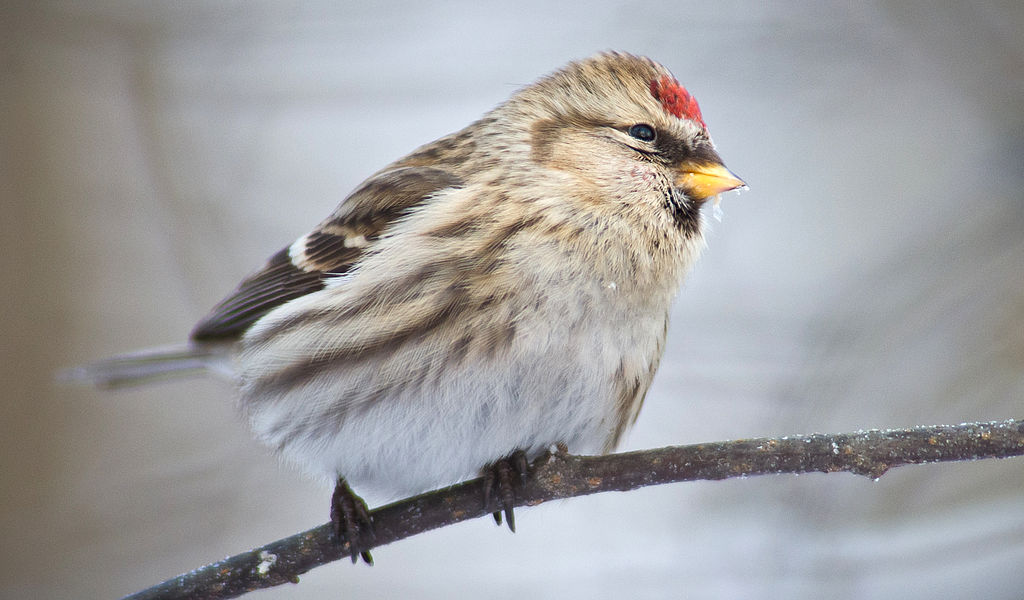
Coloration and Markings: A beautiful blending of colors is present in the Common Redpoll. The wings, back, and tail are a mix of brown and white streaks while the breast and lower belly are the same but with a higher white content in the underbelly and some rose-red coloration at the top of the breast which continues all the way up under the bill. The rest of the face is brown and white with a brilliant red patch on the forward half of the head. These birds have small, yellow bills which are lightly curved.
Size: These birds measure in at 4.7 – 5.5 inches in length with wingspans of 7.5 to 8.7 inches.
Habitat: These birds love fields and conifer forests. They aren’t shy about visiting backyard feeders, however, so keep an eye out for them.
Diet: Broken up or small Black Oil sunflower seeds and Nyjer are favorites of these birds (especially the latter!).
Supporting cast (Other Backyard Birds of Virginia That Might Pay You a Visit)
We’re all about the birdwatching here and we want to make sure that you leave this article with plenty of tips and birds to look for. To this effect, aside from our ‘Seasonal Stars’ we’ve got a supporting cast of birds that you can see year-round, just in case you missed the ones that we have listed above. Look for one or more of these and see how many that you can find:
- European Starling
- House Finch
- Downy Woodpecker
- Blue Jay
- American Robin
European Starling – Sturnus vulgaris
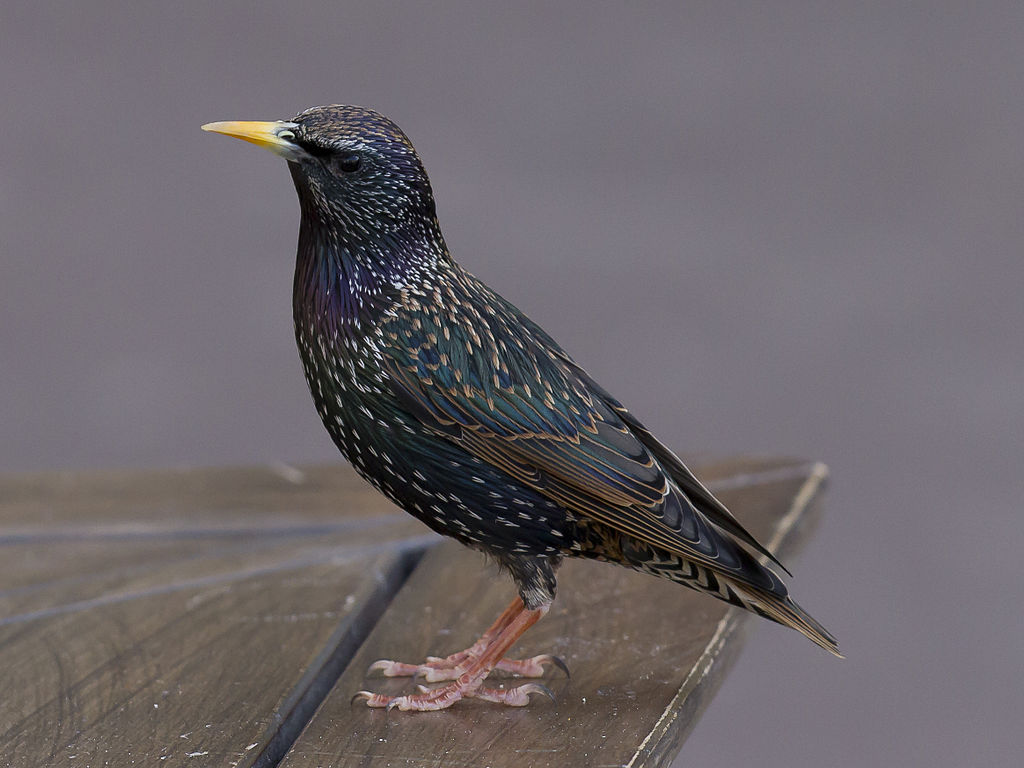
Coloration and Markings: European Starlings are beautiful and easy to recognize. Their entire bodies are a shiny mix of black and purple and they have long, straight yellow bills. In the winter it’s a different story, however, as their plumage changes to brown with white spots!
Size: Roughly Robin-sized, these birds measure in at 7.9 – 9.1 inches in length with wingspans of approximately 12.2 to 15.8 inches.
Habitat: These birds are very much used to humans, so anywhere that you are, they are. They tend to travel in large groups and it’s not uncommon to see a bunch of them on a telephone line, scoping the ground for quick snacks.
Diet: These birds will eat just about anything but if you really want to make them happy, go with fruits. Berries, chopped apples, and raisins will make you a new friend very quickly when it comes to the European Starling.
House Finch – Haemorhous mexicanus
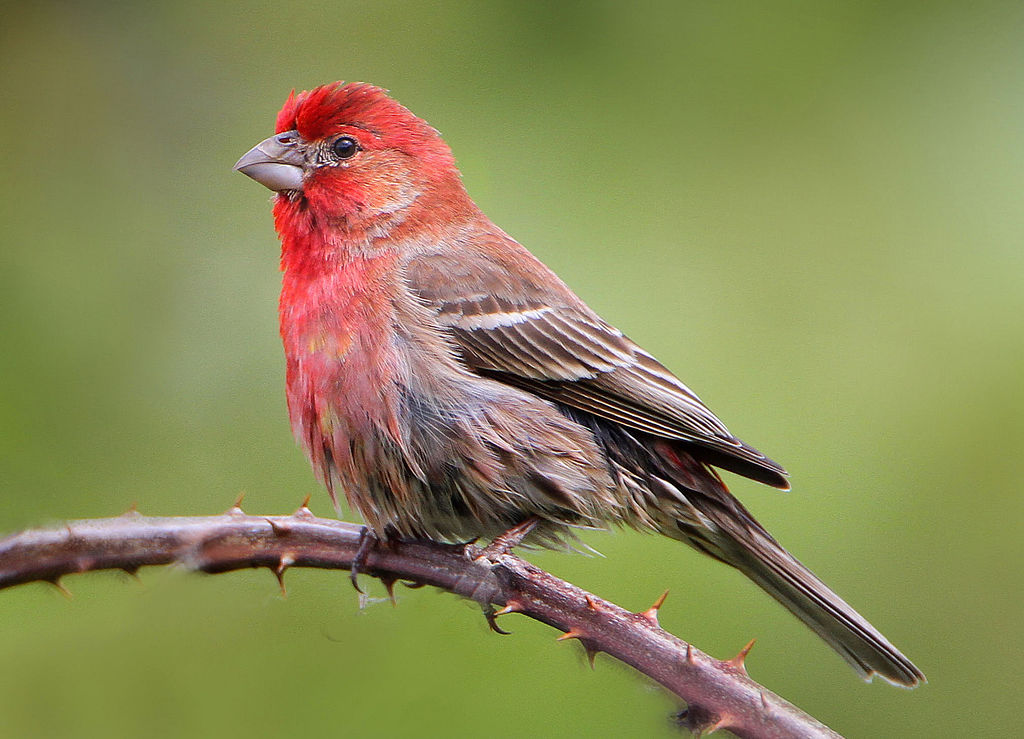
Coloration and Markings: The stunning little guys have brown-streaked backs, tails, and bellies. Their upper breast is a cherry red that continues up to the face of this bird. You will see a small amount of gray on the head, usually in the form of a zigzagging line, but the majority of the face is going to be red. These birds have small, curved silver beaks. Only the males are lucky enough to get this stunning combination, the female House Finch has no red but is gray and brown.
Size: These birds measure in at 5.1 – 5.5 inches in length with wingspans of 7.9 to 9.8 inches.
Habitat: These birds may be found a number of places, such as farms, the forest’s edge, or your own backyard. They aren’t shy of urban areas so keep an eye out and you might get lucky!
Diet: Thistle, Black Oil sunflower seeds, and most berries (they like cherries, strawberries, blackberries, peaches, and more!). Any one of these will work although make sure the Sunflower seeds are small and that you include them. House Finches definitely love eating some sunflower seeds.
Downy Woodpecker – Picoides pubescens
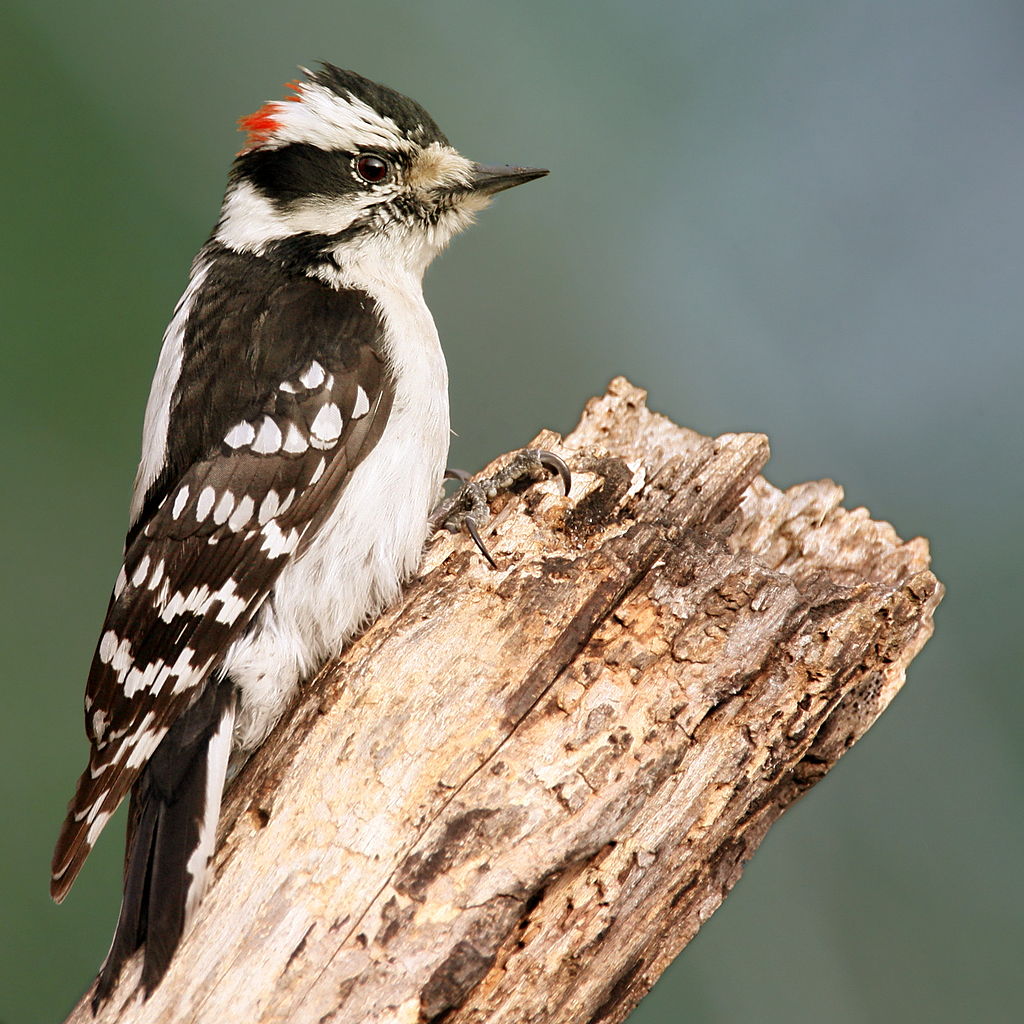
Coloration and Markings: The beautiful Downy Woodpecker has a white back with black wings. These wings have a delightful assortment of white spots that give them a checkered look. The breast and underbelly are the same white as the back. These Woodpeckers have white faces with a black ‘mustache’ line that goes almost to the back of the head and then dips into the wing. They also have a mask and a black cap. The males have a distinctive red spot on the back of this cap and this bird has a small, straight black bill.
Size: These little Woodpeckers measure in at 5.5 – 6.7 inches in length with wingspans of 9.8 to 11.8 inches.
Habitat: You can find the Downy Woodpecker in deciduous forests as well as parks, orchards, and backyards.
Diet: These little guys like millet, Black Oil sunflower seeds, peanuts, and even peanut butter!
Blue Jay – Cyanocitta cristata
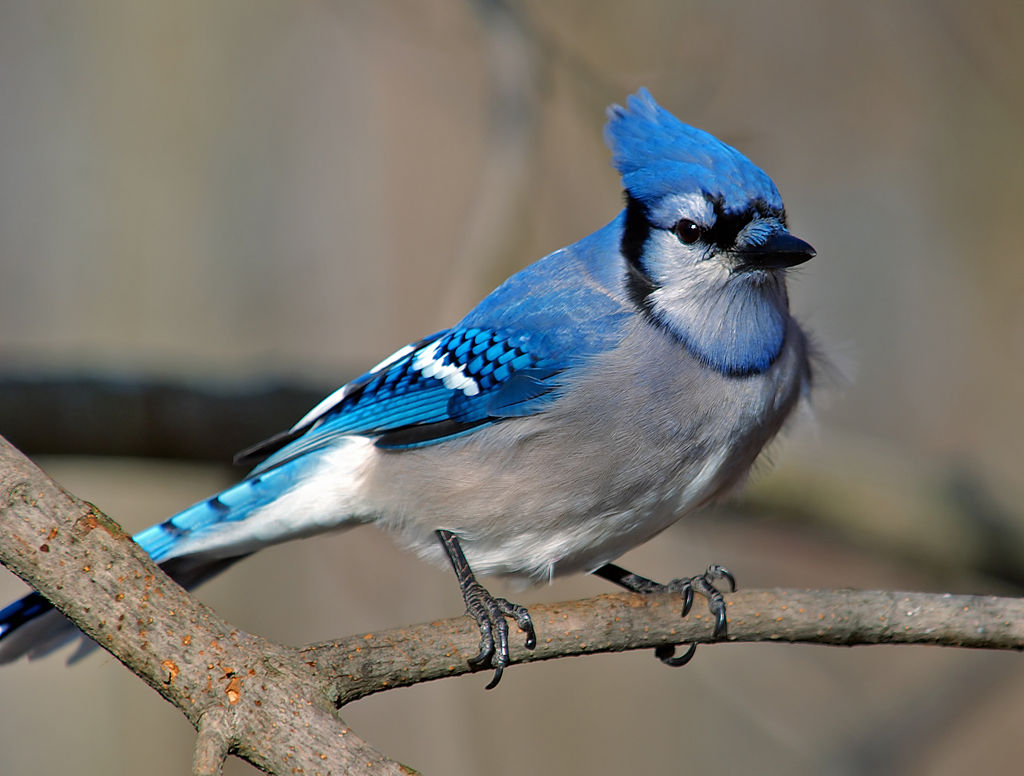
Coloration and Markings: These striking creatures really get your attention. Blue Jays have blue wings with white lines and markings, outlined in black as your gaze travels further down the wing. They have long tails and you will see little ‘square’ patterns of black dividing the blue. They have a crisp white breast and underbelly and their faces are borded with a thick black line that travels up the neck all the way to it’s magnificent blue crest. The rest of the face is white, with the exception of the bird’s mask, which looks as if it was painted abstractly on the face rather than the straight lines you often see in other birds. Blue jays have long, straight black bills.
Size: These are large birds, measuring in at 9.8 – 11.8 inches from tip to tail and with a wingspan of approximately 12.4 to 16.9 inches.
Habitat: These birds love the forest edge but when they aren’t camping they have no problem with just about any human-settled area. These are bold birds and they will happily visit your backyard for treats.
Diet: Suet, Black Oil sunflower seeds, and peanuts are favorites of this bird. They also love acorns so if you happen to have an Oak tree in your front or backyard then keep your eyes peeled.
American Robin – Turdus migratorius
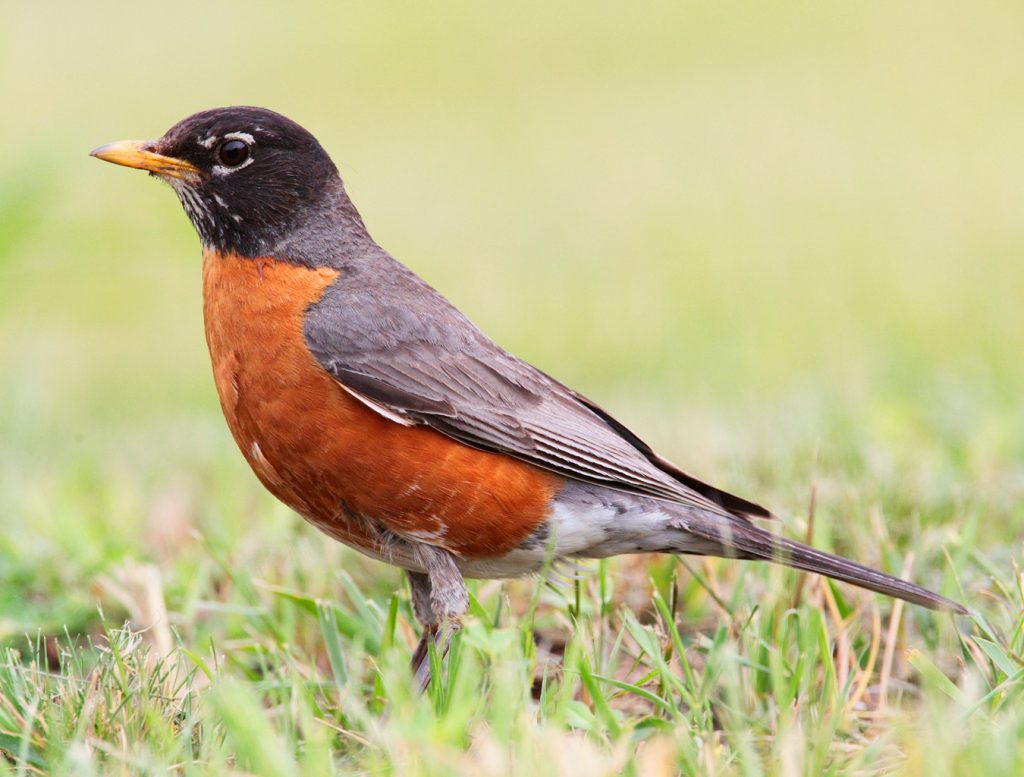
Coloration and Markings: American Robins have gray and brown wings with the same coloration on their long tails, with the exception of the underside. The undersides of the tail as well as the rump are snowy white. The breast and underbelly, by contrast, are a delightful orange which goes all the way up to the base of the Robin’s chin. The face is black, with some white outlining around the eye, and this bird has a small yellow bill which is slightly curved.
Size: These Robins measure in at 7.9 – 11 inches in length (on average) and carry wingspans of approximately 12.2 to 15.8 inches.
Habitat: These birds love parks, fields, and deciduous forests as well as backyards where they have been made welcome. If you see one nearby then be sure to leave something in the feeder for it and you might just get a personal visit.
Diet: Suet, chopped apples, Black Oil sunflower, and even raisins are just a few examples of foods that will compel American Robins to spend a little quality time at your feeder. Mealworms don’t hurt, either, so give some of these a try and see what happens!
Virginia Bird Buffet
If you are looking to make your own mix to attract the most birds then we highly recommend that you visit this link for the Virginia Cooperative Extension: https://www.pubs.ext.vt.edu/420/420-006/420-006.html
They have an exhaustive list available that can help you put together mixes for some birds and can even advise you how to discourage others! If you don’t have the time, some basics that can attract the most birds include:
- Suet
- Nyjer Thistle
- Black Oil Sunflower
- Peanuts
- White Proso Millet
Virginia Birding Hot Spots
Virginia has a number of spots where the Chirparazzi flock to see and photograph the stunning celebrities of the sky. We’ve collected some of Virginia’s hotspot trails where you can go to spend an amazing evening hunting for a glimpse of your fine feathered friends. We’ve got trails at every compass point and central Virginia so that you can find one close to you! Check out one of the following:
- Northern hotspot – Virginia Blue Ridge Railway Trail
- Eastern hotspot – Kempsville Road Trail
- Southern hotspot – Riverwalk Trail
- Western hotspot – Mendota Trail
- Central hotspot – James River Heritage Trail (Blackwater Creek Natural Area)
Detailed descriptions of each location as well as information regarding visiting and what birds you can see at these locations may be found at https://www.traillink.com/statewactivity/va-birding-trails/
Final Thoughts
We hope that you have enjoyed reading our list of the ‘Popular Backyard Birds of Virginia’ as much as we have enjoyed writing it for you. Virginia is one of those states that shows a lot of love for wildlife and their dedication to birders and other wildlife fans alike is much appreciated. We wish you happy bird-spotting and don’t forget to keep those feeders well and thoughtfully provisioned!
